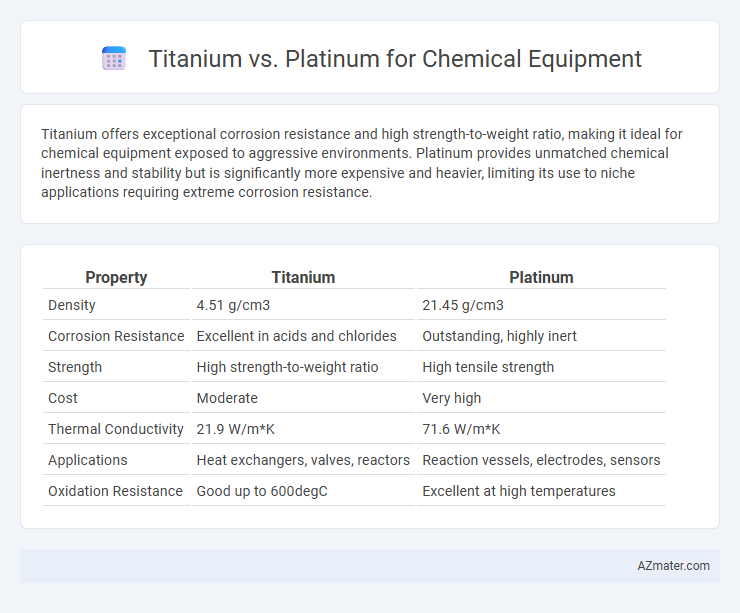Titanium offers exceptional corrosion resistance and high strength-to-weight ratio, making it ideal for chemical equipment exposed to aggressive environments. Platinum provides unmatched chemical inertness and stability but is significantly more expensive and heavier, limiting its use to niche applications requiring extreme corrosion resistance.
Table of Comparison
| Property | Titanium | Platinum |
|---|---|---|
| Density | 4.51 g/cm3 | 21.45 g/cm3 |
| Corrosion Resistance | Excellent in acids and chlorides | Outstanding, highly inert |
| Strength | High strength-to-weight ratio | High tensile strength |
| Cost | Moderate | Very high |
| Thermal Conductivity | 21.9 W/m*K | 71.6 W/m*K |
| Applications | Heat exchangers, valves, reactors | Reaction vessels, electrodes, sensors |
| Oxidation Resistance | Good up to 600degC | Excellent at high temperatures |
Introduction: Titanium vs Platinum in Chemical Equipment
Titanium and platinum are both highly valued materials in chemical equipment due to their exceptional corrosion resistance. Titanium is favored for its lightweight strength and resistance to a wide range of acids and chlorides, making it ideal for aggressive chemical environments. Platinum, though more expensive, offers superior chemical inertness and high-temperature stability, often used in critical catalytic and electrochemical applications.
Material Composition and Properties
Titanium offers excellent corrosion resistance, especially against chloride and acidic environments, due to its strong passivation layer of titanium dioxide, making it ideal for chemical equipment exposed to harsh chemicals. Platinum, a noble metal, exhibits superior chemical inertness and high resistance to oxidation and corrosion, maintaining stability at extreme temperatures but at a significantly higher cost compared to titanium. Both metals provide excellent durability and resistance to chemical degradation, yet titanium's lightweight and strength-to-weight ratio make it more practical for large-scale industrial applications, whereas platinum is favored for specialized, high-precision equipment requiring unparalleled chemical resistance.
Corrosion Resistance Comparison
Titanium exhibits superior corrosion resistance compared to platinum in harsh chemical environments, particularly against chlorides, acidic solutions, and oxidizing agents. Its passive oxide layer provides exceptional protection from pitting and crevice corrosion, making it ideal for seawater and aggressive chemical processing. Platinum, while highly resistant to oxidation and general corrosion, is more susceptible to attack by halogenated compounds, limiting its use where localized corrosion is critical.
Thermal Stability and Heat Resistance
Titanium exhibits excellent thermal stability with a melting point of 1,668degC, making it highly resistant to heat deformation in chemical equipment applications. Platinum, with a higher melting point of 1,768degC, offers superior heat resistance and maintains structural integrity under extreme thermal conditions. Both metals resist corrosion in harsh chemical environments, but platinum's higher heat tolerance makes it preferable for processes involving elevated temperatures.
Mechanical Strength and Durability
Titanium offers exceptional mechanical strength and corrosion resistance, making it ideal for chemical equipment exposed to highly aggressive environments. Platinum, while highly durable and corrosion-resistant, typically exhibits lower mechanical strength compared to titanium and is often reserved for applications requiring superior chemical inertness and catalytic properties. The choice between titanium and platinum depends on balancing mechanical performance with chemical resistance in industrial settings.
Chemical Compatibility with Industrial Compounds
Titanium offers superior resistance to corrosive industrial chemicals such as chlorides, acids, and alkalis, making it ideal for handling aggressive compounds like hydrochloric acid and sulfuric acid in chemical equipment. Platinum exhibits exceptional chemical inertness and stability at high temperatures, resisting oxidation and corrosion even in harsh environments involving strong acids and oxidizing agents. Selecting titanium or platinum depends on specific chemical compatibility requirements, temperature conditions, and cost considerations in industrial applications.
Cost Analysis: Titanium vs Platinum
Titanium offers a cost-effective alternative to platinum in chemical equipment due to its lower raw material and manufacturing expenses, while maintaining excellent corrosion resistance and strength. Platinum, though superior in chemical inertness and catalytic properties, commands significantly higher market prices, increasing initial investment and replacement costs. Evaluating total lifecycle expenses, titanium's affordability and durability often result in more economical solutions for large-scale or extended-use industrial applications.
Maintenance and Longevity
Titanium exhibits exceptional corrosion resistance and requires minimal maintenance in chemical equipment, significantly reducing downtime and repair costs. Platinum, while highly durable with excellent resistance to acids and high temperatures, demands meticulous handling and occasional surface refurbishment to preserve its functionality. The extended longevity of titanium, combined with its lighter weight and lower maintenance needs, often makes it the preferred choice for long-term chemical processing applications.
Environmental and Safety Considerations
Titanium offers superior corrosion resistance in aggressive chemical environments, significantly reducing the risk of contamination and hazardous leaks compared to platinum. Its lightweight and non-toxic properties contribute to safer handling and lower overall environmental impact during both manufacturing and operation. Platinum, while highly inert and effective in catalytic processes, presents higher toxicity risks and environmental concerns due to its mining and refining processes.
Applications and Industry Preferences
Titanium exhibits exceptional corrosion resistance and high strength-to-weight ratio, making it the preferred choice in the chemical processing industry for handling highly corrosive substances and elevated temperatures. Platinum, valued for its excellent catalytic properties and inertness, is predominantly used in specialized applications such as catalysts and electrodes in chemical reactors. Industry preferences lean towards titanium for large-scale equipment due to cost-effectiveness and durability, while platinum is reserved for niche roles requiring superior chemical stability and conductivity.

Infographic: Titanium vs Platinum for Chemical Equipment
 azmater.com
azmater.com